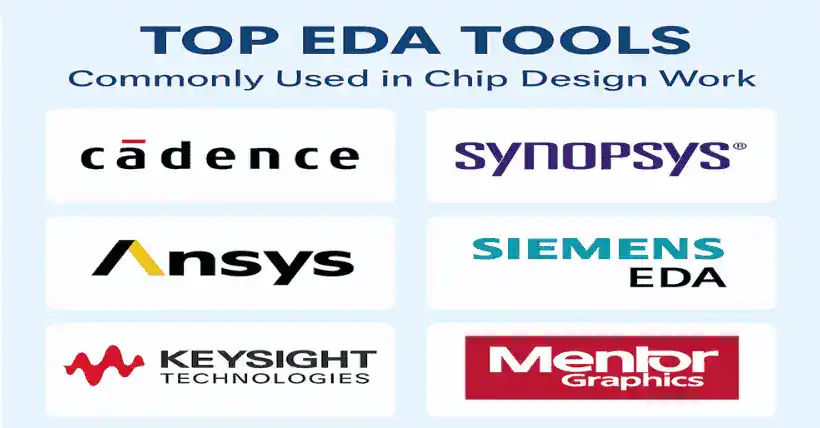01
Common Software Tools for Front-End Chip Design Work
Front-end design focuses on implementing the logical functions of a chip. The core processes include specification definition, HDL design, simulation and verification, logic synthesis, and timing analysis.
1. HDL Coding Tools
Used to write design code in hardware description languages (such as Verilog or VHDL), similar to an IDE for software programmers.
- VisualHDL (Summit)
- Renoir (Mentor)
- Composer (Cadence)
These tools provide graphical or textual environments and support modular and hierarchical design.
2. Simulation and Verification Tools
Simulation is like “unit testing in software,” verifying whether the design meets the specification requirements.
- ModelSim (Mentor): Supports Verilog/VHDL; widely used in education and early-stage verification.
- VCS (Synopsys): Suitable for complex designs and large-scale simulations.
- NC-Verilog, Verilog-XL (Cadence): Powerful performance; integrated into Cadence design flow.
- VSS, Leapfrog (Synopsys/Cadence): Often used for VHDL.
Simulation can be divided into pre-simulation (functional verification) and post-simulation (with delays to verify actual timing).
3. Logic Synthesis Tools
Convert HDL code into gate-level netlists, equivalent to turning “abstract algorithms” into “logical circuit implementations.”
- Design Compiler (Synopsys): Industry standard; supports optimization for area, power, and speed.
- BuildGates, Ambit (Cadence)
- Leonardo (Mentor)
Logic synthesis relies on standard cell libraries specific to a given process technology.
4. Static Timing Analysis Tools (STA)
Like auditors, check if the timing relationships of data transmission are reasonable.
- PrimeTime (Synopsys): De facto standard; supports complex constraint analysis.
- Tempus, Pearl (Cadence)
- SST Velocity (Mentor)
Focuses on setup time, hold time, and other constraints to prevent chips from being “functionally correct but unstable.”
5. Formal Verification Tools
Verify consistency of functionality before and after synthesis to prevent logic deformation during synthesis.
- Formality (Synopsys)
- LEC, FormalCheck (Cadence)
- FormalPro (Mentor)
This is like “checking whether source code and compiled code have consistent semantics.”
02
Common Software Tools for Back-End Design
Back-end design mainly focuses on implementing the logical circuit as a physical layout, involving routing, placement, clock trees, parasitic extraction, etc.
1. DFT Tools (Design for Testability)
Add test structures to the design so the chip’s functional correctness can be verified after manufacturing.
- DFT Compiler (Synopsys): Inserts scan chains
- TetraMAX (Synopsys): Generates test vectors (ATPG)
- MBIST Architect (Mentor): Memory testing
- BSDArchit (Mentor): Boundary scan technology
DFT is a key step to enable the chip to “self-diagnose.”
2. Placement and Routing Tools
Convert gate-level netlists into physical layouts, determining the placement and routing of devices.
- IC Compiler / Astro (Synopsys)
- Encounter / Silicon Ensemble (Cadence)
- Design Planner (Mentor)
“Floorplan” is like a building blueprint, while “Place & Route” is like construction wiring, having a significant impact on area, power, and performance.
3. CTS Tools (Clock Tree Synthesis)
Build the chip’s “central nervous system” by optimizing clock paths to all registers.
- Clock Tree Compiler (Synopsys)
- CT-Gen (Cadence)
Ensure clock signals arrive synchronously across the chip.
4. Parasitic Extraction Tools
Extract capacitance, resistance, and coupling effects in wires to evaluate signal integrity.
- Star-RCXT (Synopsys)
- Calibre xRC (Mentor)
- Assure RCX (Cadence)
Used for post-simulation and signal integrity analysis.
5. Physical Verification Tools
Ensure the design meets manufacturing requirements and is free from logic or physical errors.
- LVS (Layout vs. Schematic)
- DRC (Design Rule Check)
Common tools:
- Hercules (Synopsys)
- Dracula, Assura (Cadence)
- Calibre (Mentor): Most widely used verification platform in the industry.
6. Post-Simulation Tools
Introduce parasitic effects into simulations to verify final design timing stability. Uses the same tools as pre-simulation but adds SDF delay information.
03
Summary Analogy (Full Software Flow)
| Stage | Role Analog | Key Tools |
|---|---|---|
| Specification | Requirement Analyst | None |
| HDL Design | Programmer | VisualHDL, Renoir |
| Functional Sim | Software Tester | ModelSim, VCS |
| Synthesis | Compiler | Design Compiler |
| STA | Auditor | PrimeTime |
| Formal Verification | Compliance Reviewer | Formality, LEC |
| DFT | Medical Engineer | DFT Compiler, TetraMAX |
| Placement & Route | Construction Team | IC Compiler, Encounter |
| CTS | Chip Scheduler | Clock Tree Compiler |
| Parasitic Extract | Simulation Modeler | Star-RCXT, Calibre xRC |
| Physical Verif. | Safety Inspector | Calibre, Hercules |
| Post-Sim | System Integrator | ModelSim + SDF |

Disclaimer:
- This channel does not make any representations or warranties regarding the availability, accuracy, timeliness, effectiveness, or completeness of any information posted. It hereby disclaims any liability or consequences arising from the use of the information.
- This channel is non-commercial and non-profit. The re-posted content does not signify endorsement of its views or responsibility for its authenticity. It does not intend to constitute any other guidance. This channel is not liable for any inaccuracies or errors in the re-posted or published information, directly or indirectly.
- Some data, materials, text, images, etc., used in this channel are sourced from the internet, and all reposts are duly credited to their sources. If you discover any work that infringes on your intellectual property rights or personal legal interests, please contact us, and we will promptly modify or remove it.



